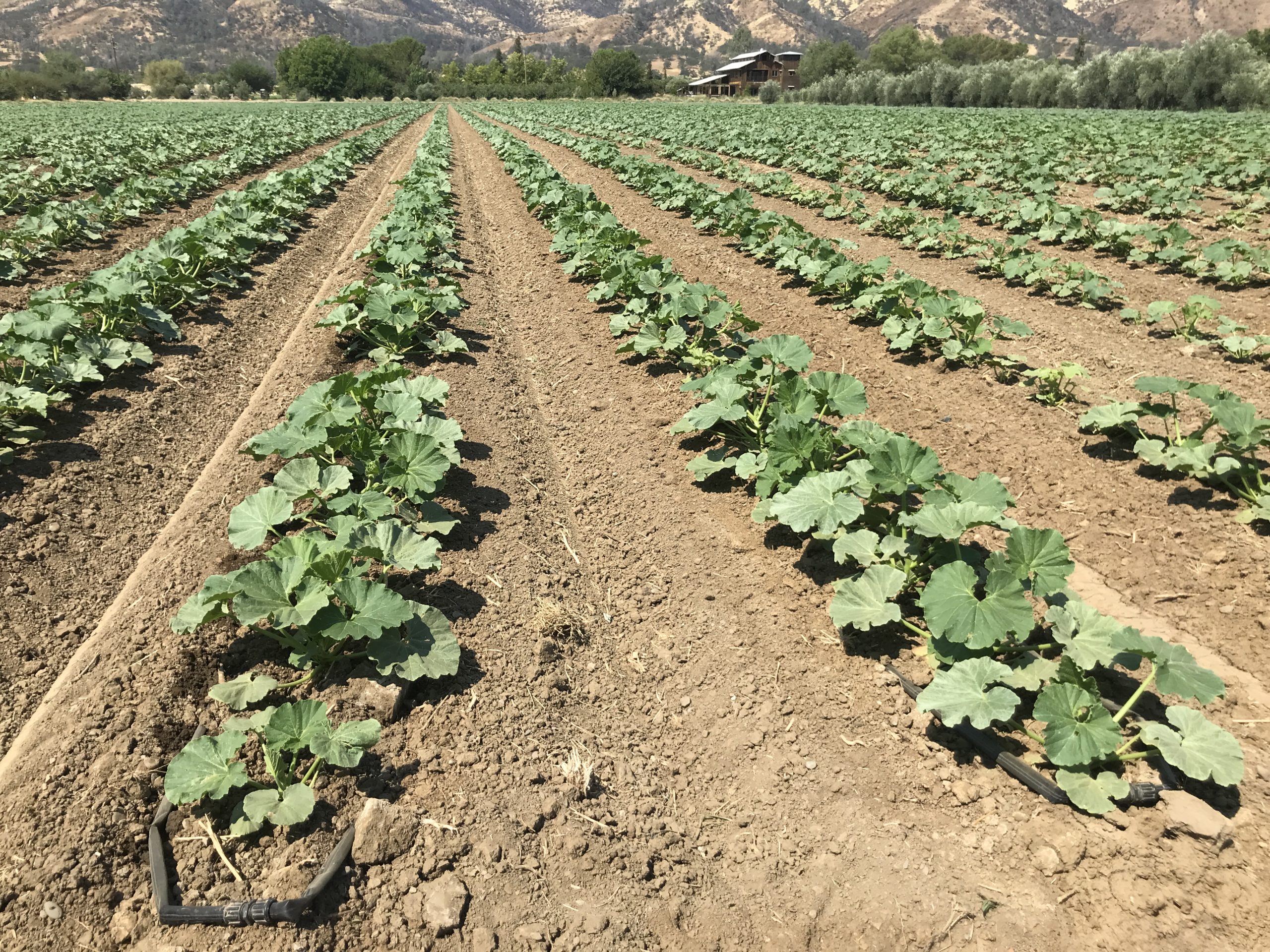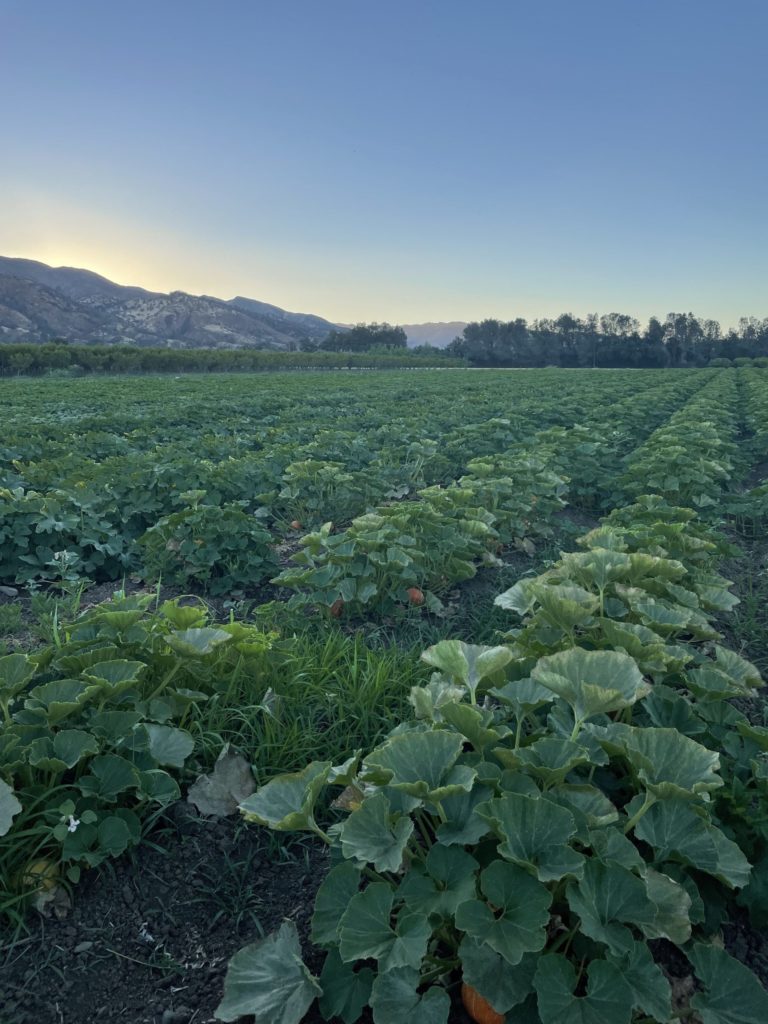
We are heading into our 3rd week of triple digit temperatures here on the farm. High heat creates stress on everything and everyone. Plants and animals need more water, and we humans do too as we remain in the fields to do our work. We emphasize frequent water consumption, more breaks, monitoring for heat stress (in yourself and team members), and we try to be done earlier in the day.
The heat is also providing mental and emotional stress. This is proving to be a challenging year in terms of keeping everything moist. We have cut back on fields in production by 15% and are trying to stretch the various water sources we have in order to keep plants productive.
The farm gets our water primarily from five different wells and from the surface waters in Cache Creek. The Creek is primarily water that is captured and released from Clear Lake and from Indian Valley Reservoir. Below our farm, the river is now basically dry. There is also some water from springs and we are fortunate enough to have many fields proximate to spring-fed pools. We are crossing our fingers that these spring-fed pools will hold up to get us through the season and into fall plantings. Water means jobs for our crew and a cash flow to keep the farm wheels turning. We can use our wells, but it impacts neighboring farms if we pump too much. Water will determine if we can grow cover crops for our animals and soil, and have the ability to fill boxes with produce.
Our wells are somewhat ephemeral. Water running in side streams that come from the hills to the west after rainstorms fills our aquifers and allows us to pump for another year. The rains of last fall were enough to help with recharge as all of the streams had water running for more than three weeks. We have been sounding our wells and charting water levels for the past three years to get a better handle on how our particular wells respond to the pumping that we are doing. We are also keeping an eye on the neighbor’s well to see when it draws down to a point where he may have no water.
We have sought to build resilience and flexibility into the design of our farm. We choose to grow a wide variety of crops to hedge both the coming high heat and water use. Diversity also hedges the persistent reality that farm prices for a crop may be good this year but challenging next year. Like flies to honey, farmers will often leap to invest in what was last year’s good return. We look to avoid the low prices that often result from the exuberance that brings excess (and corresponding low prices) through cropping diversity.
In focusing on soil health, we have sought to help our soils retain more water and infiltrate more water when rains do come. Building organic matter in soil through cover crops and compost is a strategy to make each drop of water go further. Most all summer fields are on drip irrigation to be more precise in our water application. Flexibility in the tools we use to water has been part of our plan for resiliency for years.
We have chosen market flexibility with the stable direct associations that come from our weekly presence at three farmers markets, the steady solid economy of our CSA (you all), good long-term relations with independent markets and restaurants, and then to our wholesale accounts, who are also long term friendships that we look to cultivate and pick to order a day fresher than most farms—ask for it this morning and we will have it to you tomorrow.
We also have created a farm design that values diversity in our ecological health. I have written about the many ways we think about our pollinators, predatory spiders, bumblebees, butterflies, ladybugs, bats, birds (especially owls), snakes, and soil microbes and look to make a home here for them. They all require a suitable home and some loving attention. We try to set a table for their sustenance- pollen and nectar for bees; field mouse or gopher for our owls; spiders need dried grassy untilled edges where to spin webs; or, for our soil microbes, plenty of cover crops and green roots to bring them food from thin air (generally carbon and nitrogen, elements harvested for free through green plants) used to make healthy soil.
All we need to do is pay attention, choose the types of plants at the right time, plant the seed just so….. and add water.
Mark Twain said that ‘Whisky is for drinking and water is for fighting over”. So it is, that the history of California Agriculture has been the history of the extraction, diversion, damming, possessing, and appropriation of water and the tools to move water- allowing the vast interior desserts of the mid state to bloom.
Since the mid 1800’s farmers and developers appropriated water from the lakes and rivers of the Central Valley to grow crops. Lakes were drained water was diverted and sent south for the houses and new plantings of almonds, grapes, cotton, tomatoes and fruit trees, and pumps and deep wells were built to access groundwater. It became a long slog of battles over who gets the water. This year the conflicts are especially intense.
In most seasons in California the rain, snow, storage and underground sources do not meet the water needs of people, farms, and the environmental needs of healthy rivers and fisheries. Mark Arax, in his remarkable and thorough book The Dreamt Land chronicles the history of water in California, the history of water and farming, and the individuals and forces that have shaped our water use policies in California.
This history includes exploitation from early mines where rules were built upon “first in line made first in right”, to the riparian rights enjoyed by those proximate to a stream, to the major transfers of water from north to south, and to today’s quandary of an over-extracted and over-promised resource.
California Agriculture’s history is remarkably productive given our water limitations and all the water-moving that has been required to grow. It is also a story of largely ungoverned extraction, over-planting and appropriation that has led us to depletion and has us a trajectory of widespread collapse. It is not a pattern that can continue and is showing the stresses as this 1200 year mega drought in the West continues. As farmers and investment funds drill deeper to irrigate new plantings, those on the edges and under-capitalized farmers are the first to run out of water and almost certainly lack the resources to go deeper.
Our farm may squeak thorough this season. Fall will be touch and go. We will keep you apprised of our adjustments as we enter the next few months. Check out Mark Arax’s book; it is a remarkable history of the past, present and the story that makes California agriculture.
Thank you for your support for our farm,
Paul Muller

